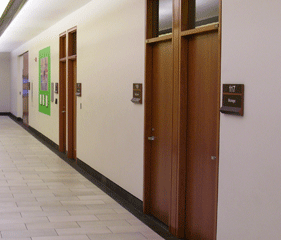Government policies can sometimes shape entire industries. Never has this been more true than with the Americans with Disabilities Act (ADA), which was signed into law by George H.W. Bush in 1992. The ADA not only opened up accessibility as part of the approval process for every building, but it helped create entire new industries that have spread accessible sign fabrication and materials technology from a small cottage industry to a global business.
Unfortunately the ADA also created a real mess for sign builders and designers. The ADA was civil rights legislation, and states were required to interpret this new legislation into their building codes (which were generally updated every few years). Faced with hitting a moving target of different state codes and varying interpretation among local officials, many sign makers often followed the path of least resistance and avoided creative solutions.
Eventually the ADA matured. The American National Standards Institute (ANSI) and the International Code Council (ICC) eventually updated their codes, which were adopted by the ADA. This created confusion though, as various states updated their codes beyond the first ADA while others did not. (And states like California decided to march to the beat of their own drum.)
Mike Santos, a principle with Nova Polymers and a well-known ADA educator to the sign community, highlights this continued confusion between state and federal codes as a problem in the sign industry. “We’ve been doing programs for the past seven years, and the issues have stayed the same,” he says. “Sign heights, color contrast, and even Braille doming are simple issues, but they’re still confusing, because of the disparity between federal and state codes.
“The new ADA is supposed to solve this, but I still see another few years of confusion.”
A Better Code Though Ambiguities Still Exist
Most experts agree that the new ADA is an improvement over the old, providing greater flexibility while being more logical. Particularly effective in the code is the separation between information for the visually impaired and information for the blind. This change reflected the reality that these two groups have vastly divergent needs.
While improving the code, this change does make it more complex—particularly for code official interpretation. Sign designers and builders must be even more direct when using and explaining the code.
The Top Issues in the New ADA
While there are dozens of complex issues with the ADA, the general consensus is that a small number dominate the interpretation issues between sign builders and designers. These include:
 Sign heights. A seemingly simple issue, sign height has become among the most troublesome for sign builders and designers (pictured). Perhaps the dominant issue change in the new ADA is the change in sign heights from sixty inches to the center of the sign to a range of forty-eight to sixty inches from the bottom to the top of sign text.
Sign heights. A seemingly simple issue, sign height has become among the most troublesome for sign builders and designers (pictured). Perhaps the dominant issue change in the new ADA is the change in sign heights from sixty inches to the center of the sign to a range of forty-eight to sixty inches from the bottom to the top of sign text.
This change was sorely needed, since sixty inches on center resulted in inconsistent sign heights on signs.
According to Matt Williams of Dixie Graphics, this one change has made huge ripples across the sign industry. “‘Sixty’ on center never made a great deal of sense, since the blind read information on signs and not the signs themselves, but it was always an easy code to understand,” he says. “Now code officials have to think about how this works, and companies need to train their own staff.
“Clients also need to gauge what they need to do with their existing systems.”
Sign placement. The new ADA provides greater guidance for the placement of signs, allowing tactile signs to be placed on the push side of doors with a closing mechanism, among other placement changes. This change clarifies the issue of signs on restroom doors.
Doming. Doming or rounding was never explicitly described in the code, creating confusion in the industry as to what Braille methodology makes the most sense. The new ADA provides more clarity providing for doming or rounding of Braille, which most ADA methodologies—from chemical etching to photopolymer to raster Braille—can accomplish.
Color contrast. Some parts of the ADA grew more specific, but this one issue is actually more general. The code itself hasn’t changed, still allowing for dark signs on a light background or light signs on a dark background.
However the 70 percent color contrast recommendation is no longer in the code. In other words, there’s now no contrast level requirement. This doesn’t prevent a state from passing specific color contrast codes or recommendations, but none has done so yet.
This doesn’t mean that signs can be extremely low contrast. Signs still need to be visible. A lawsuit can still be made, even if not explicitly in the code.
 Temporary signs. A recurring issue over the last few years has been what to consider temporary and what to consider permanent identification on signs. For example, addressing systems can be used to cover any destination considered temporary, but in a few instances, it’s important to use the full name (pictured).
Temporary signs. A recurring issue over the last few years has been what to consider temporary and what to consider permanent identification on signs. For example, addressing systems can be used to cover any destination considered temporary, but in a few instances, it’s important to use the full name (pictured).
The new ADA solidifies the definition of an identification sign as representing destinations that are permanent for more than seven days (generally interpreted as rooms that have equipment that can’t be easily removed—like bathrooms and kitchens). All other destinations—like offices with changing names—can be represented by alphanumerical addresses.
Dual signs. Because of the separation in guidelines for the blind and the visually impaired in the new ADA, there’s a specific section on dual signs or signs that can utilize information for both the blind and the visually impaired. Braille and raised letters in this approach can be small and blend in with its background, while the visual information on the sign can use serif fonts and much larger type (making effective signs for both groups).
 Unfortunately these signs are rarely used. Roger Whitehouse, a pioneer in accessible design, worked with ASI to create flexible dual modular signs and laments the lack of understanding that has hindered their use. He believes that, with the new ADA code, these types of signs—which meet the needs of the blind and the visually disabled—will become more prevalent (pictured). “After all the years of code development and design experiments showing their effectiveness, there’s still fear of using dual signs,” he says. “Hopefully the new ADA will finally encourage [their] use.”
Unfortunately these signs are rarely used. Roger Whitehouse, a pioneer in accessible design, worked with ASI to create flexible dual modular signs and laments the lack of understanding that has hindered their use. He believes that, with the new ADA code, these types of signs—which meet the needs of the blind and the visually disabled—will become more prevalent (pictured). “After all the years of code development and design experiments showing their effectiveness, there’s still fear of using dual signs,” he says. “Hopefully the new ADA will finally encourage [their] use.”
Visual letter heights. The old ADA was uniform with its guidance for visual letter heights—three inches minimum for all overhead signs. This made it all but impossible to put in overhead wayfinding signs in most hospitals and other low-ceiling spaces.
 The new code though allows for letter heights that better fit the environment they’re in, which is particularly important in transportation environments (pictured). The new ADA provides a two-inch minimum sign height along with height requirements above three inches for large distances and heights.
The new code though allows for letter heights that better fit the environment they’re in, which is particularly important in transportation environments (pictured). The new ADA provides a two-inch minimum sign height along with height requirements above three inches for large distances and heights.
Chris Calori of Calori & Vanden-Eynden Design Consultants uses this example to show the greater understanding of both code flexibility and legibility. “In the old ADA, the three-inch height pretty much insured that there would be three-inch letters everywhere, making them too big in some spots and too small in others,” he explains. “Accepting a two-inch standard—but writing in language for adjusting to greater distances—allows the designer to make the best decision for the facility.”
Learn the New ADA
The new ADA offers designers and fabricators many more options. For those who want to get to know the code at a deeper level, it’s important to first understand the context of the code by reading it in detail.
The issues listed in this article are only the dominant ones. It’s important to review how sign codes sit inside of the entire ADA to see where it will impact your specific design decisions.
To download an HTML or PDF copy of the new ADA, CLICK HERE.
Craig Berger is principal of Craig Berger Management Consulting, a firm focused on devising marketing, education, and management approaches for designers, fabricators, manufacturers, and clients. He can be reached at [email protected].











